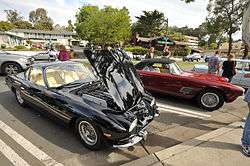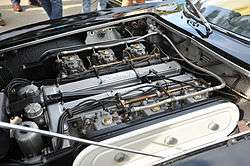Lamborghini 350 GT
| Lamborghini 350 GT | |
|---|---|
 | |
| Overview | |
| Manufacturer |
Carrozzeria Touring for Automobili Lamborghini S.p.A[1] |
| Production |
May 1964–1966[2] 120 built[1] |
| Assembly | Sant'Agata, Italy[2] |
| Designer | Carrozzeria Touring |
| Body and chassis | |
| Class | Grand tourer |
| Body style | 2-door coupé |
| Layout | FR layout |
| Powertrain | |
| Engine | 3,464 cc (211.4 cu in) 60° aluminium V12 DOHC |
| Power output | 280 bhp (284 PS; 209 kW) and 325 N⋅m (240 lbf⋅ft) of torque |
| Transmission | 5-speed ZF manual[2] |
| Dimensions | |
| Wheelbase | 2,550 mm (100.4 in) |
| Width | 1,730 mm (68.1 in) |
| Height | 1,220 mm (48.0 in) |
| Kerb weight | 1,450 kg (3,197 lb) |
| Chronology | |
| Predecessor | Lamborghini 350GTV |
| Successor | Lamborghini 400GT |





The Lamborghini 350 GT was a grand tourer manufactured by Lamborghini between 1964 and 1966. It was the first production vehicle produced by Lamborghini.[1] The 350 GT was based on the earlier Lamborghini 350 GTV and was equipped with a 3.5 liter V12 engine and a 2-door coupé body by Carrozzeria Touring. The 350 GT debuted at the March 1964 Geneva Motor Show and production began the following May. The success of this model ensured the company's survival, establishing it as a viable competitor with rival manufacturer Ferrari.[3][4][2]
History
Initial design team
After the testing of his prototype Lamborghini engine in May 1963, then-lead engineer Giotto Bizzarrini left the company.[3] The following month Ferruccio Lamborghini tasked engineer Gian Paolo Dallara with developing a production version of Bizzarrini's 350GTV grand tourer.[4] Dallara was assisted in this project by engineer Paolo Stanzani and test driver Bob Wallace.[3]
Dallara and Stanzani quickly realized that the 350 GTV was not properly designed for mass production. They began working in parallel on two projects that would result in the production 350 GT. First, they began de-tuning the original Bizzarrini engine and redesigning the original Bizzarrini chassis for street use.[3] Second, they started readying the 350 GTV for its late-October 1963 Turin Auto Show debut, where Lamborghini hoped it would raise interest in the eventual production 350 GT.[5]
Redesigning the GTV Prototype
As equipped to the 350 GTV, the Bizzarrini-designed 3.5 liter V12 was essentially a race motor, potentially developing 400 horsepower (300 kW) at 11,000rpm.[6] In order to fit his grand touring car with a smoother, more pleasant, longer-lasting engine that would be "good for 40,000 hard miles between services," Ferruccio had Dallara and Wallace de-tune a version of this prototype GTV motor for street use.[4][3] This included:[4]
- Replacing the elaborate and costly racing-style dry sump oiling system with a conventional wet sump system
- Reducing the compression ratio from 11.0:1 or above to 9.4:1
- Cutting back on the exotic materials specified for the crankshaft and other components to reduce cost
- Relocating the distributors to more accessible positions on the fronts of the exhaust camshafts
- Adoption of a single, very tall Lamborghini-made oil filter
- Replacing the expensive 36 mm vertical racing Weber carburetors with conventional side-draft 40 DCOE Webers
- Softening the cam profiles for smoother running during street driving
This first "detuned" L350 engine was tested on October 3, 1963.[7] The result—later fit in the 350 GT—was a very capable 270 bhp power plant that could reach 254 kilometres per hour (158 mph) in top form.[4][8]
While this 350 GT design work continued, the 350 GTV prototype was rushed to completion for the upcoming October 26 press meeting and the subsequent inauguration of the Turin Auto Show on the 30th.[3][5] The 350GTV was shown at the Turin Auto Show with the original Bizzarrini "racing" V-12 engine—with its downdraft webers, rear distributors, etc.—displayed alongside as it was not "adapted to the chassis."[5] The car was a static display with the suspension arms simply tack-welded in place and the engine not installed.[4][5] Lukewarm reaction to the car caused Ferruccio Lamborghini to postpone plans for immediate production and move on to introducing Dallara's new 350 GT design.[4]
In March 1964, only 5 months after the debut of the GTV in Turin, the "redesigned GTV"—now called the 350 GT—was debuted at the Geneva Auto Show.[3] It was greeted with sufficient enthusiasm that Ferruccio decided to proceed with production in May 1964.[3][4]
Manufacturing and assembly
The manufacture of the bodies was entrusted to Touring of Milan, who used their patented Superleggera method of construction to fix aluminium alloy panels directly to a tubular structure. The first 350 GT frame was fabricated by Neri and Bonacini, who continued to act as Lamborghini's chassis supplier until production of the 350 GT was underway, when the job was turned over to Marchesi.[9] Chassis and bodies were mated at Touring, which then delivered the complete assemblies—with even the bumpers in place—to the Lamborghini factory. The cars could be ordered in these colors.
The first 350 GT chassis and body, delivered to the Lamborghini factory on March 9, 1964, was named No. 101 (Touring No. 17001). That same month No. 101 debuted at the Geneva show. The first customer delivery of a 350 GT was No. 104 (Touring No. 17004), delivered on July 31, 1964.
Lamborghini produced one hundred-twenty 350 GTs before replacing it with the Lamborghini 400 GT in 1966.[1] Many 350 GTs were subsequently fit with the larger 4.0 litre engine used in the 400 GT.
Specifications
The 350 GT had an all-aluminium alloy V12 engine mated to a five-speed ZF manual transmission. It had an aluminium body (some had steel bodies), a Salisbury differential, four-wheel independent suspension, and vacuum servo-assisted Girling disc brakes all round. The 350 GT was originally fitted with Pirelli Cinturato 205VR15 tyres (CN72).[2]
It had a wheelbase of 2,550 millimetres (100.4 in), with a front and rear axle track of 1,380 millimetres (54.3 in). It measured 4,640 millimetres (182.7 in) long by 1,730 millimetres (68.1 in) wide and was by 1,220 millimetres (48.0 in) high. With its kerb weight of 1,450 kilograms (3,197 lb), the 350 GT could accelerate from 0 to 100 kilometres per hour (0.0 to 62.1 mph) in 6.8 seconds, and from 0 to 100 miles per hour (0 to 161 km/h) in 16.3 seconds, and go on to reach a top speed of 254 kilometres per hour (158 mph).[1][2][8]
Redesign features
The 350 GT shared a number of features with the 350 GTV prototype, including a four-wheel independent suspension, quad-cam V12, and an aluminium body. A number of revisions and refinements were made due to the suggestions of the Neri and Bonacini racing development shop and test driver Bob Wallace. Fixed headlights replaced the prototype's rotationally hidden variety, and twin-barrel side-draught Weber 40 DCOE 2 carburettors reduced the height of the engine, thereby negating the clearance problems of the GTV prototype, and giving the car the exceptionally low hood line Ferruccio desired.[3]
Chassis
As was the case with the motor, Bizzarrini's GTV "racing" chassis design was the basis of Dallara’s 350 GT "street" chassis. Using far heavier materials, Dallara created an extremely strong chassis from square-section tubing which provided easy entry and exit through the doors, aided in the quietness of the car, and provided a solid platform on which to mount the body, much like the Aston Martin DB4.[3]
Suspension
The suspension was fully independent, with unequal-length wishbones and concentric coil-spring-damper units. The rear suspension wishbones were offset towards the spring mountings to resist driving and braking torque, which provided superior handling.[3]
Engine
Quality control of the early 3.5 L (3,464 cc) engines was very high. Each one underwent tests for 24 hours on a Schenk Walge dynamometer, being run for the first 12 hours under electric power, and then with gasoline at increasing speeds, producing 280 bhp (284 PS; 209 kW) at 6500 rpm and 325 N⋅m (240 lbf⋅ft) of torque at 4500 rpm.[10] A detailed analysis was made of its behavior before installation in the car for at least 500 kilometres of mixed-test running by Wallace.[3]
References
| Wikimedia Commons has media related to Lamborghini 350 GT. |
- 1 2 3 4 5 "Lamborghini – History – Masterpieces – 350 GT". Automobili Lamborghini Holding Spa. Lamborghini.com. Archived from the original on 7 January 2010. Retrieved 9 January 2010.
- 1 2 3 4 5 6 "Lamborghini 350, 400 & Islero". CarsFromItaly.net. Retrieved 9 January 2010.
- 1 2 3 4 5 6 7 8 9 10 11 12 Chris Harvey. "The Lamborghinis from 350GT to Jalpa". Motor Racing Publications, 1982.
- 1 2 3 4 5 6 7 8 Pete Lyons. "The Complete Book of Lamborghini". Publications International, 1988.
- 1 2 3 4 Pasini, Stefano "Lamborghini 350 GTV." Rivista Lamborghini Review, 1991
- ↑ "The Lamborghini V-12: A Japanese Connection?".
- ↑ "The First Lamborghini L350 Engine Test".
- 1 2 "Riding The Bull". Hemmings, 2008.
- ↑ Lamborghini 400GT Monza
- ↑ "350 GT specifications". Lambocars.com. Retrieved 2018-09-17.
Lamborghini road car timeline, 1963–1989 next » | ||||||||||||||||||||||||||||
|---|---|---|---|---|---|---|---|---|---|---|---|---|---|---|---|---|---|---|---|---|---|---|---|---|---|---|---|---|
| 1960s | 1970s | 1980s | ||||||||||||||||||||||||||
| 3 | 4 | 5 | 6 | 7 | 8 | 9 | 0 | 1 | 2 | 3 | 4 | 5 | 6 | 7 | 8 | 9 | 0 | 1 | 2 | 3 | 4 | 5 | 6 | 7 | 8 | 9 | ||
| Owner | Receivership | |||||||||||||||||||||||||||
| Front/RWD | V12 | 350 GT | ||||||||||||||||||||||||||
| 400 GT | Islero | Jarama | ||||||||||||||||||||||||||
| Espada | ||||||||||||||||||||||||||||
| Mid/RWD | V8 | Silhouette | Jalpa | |||||||||||||||||||||||||
| Urraco | ||||||||||||||||||||||||||||
| V12 | Miura | Countach | ||||||||||||||||||||||||||
| Front/4WD | V12 | LM002 | ||||||||||||||||||||||||||